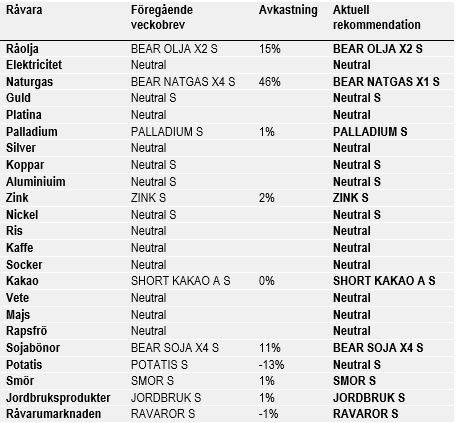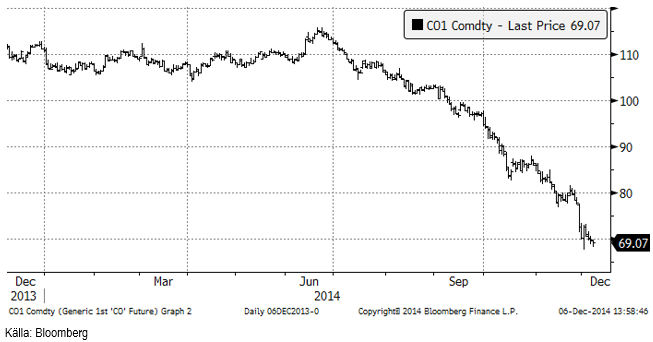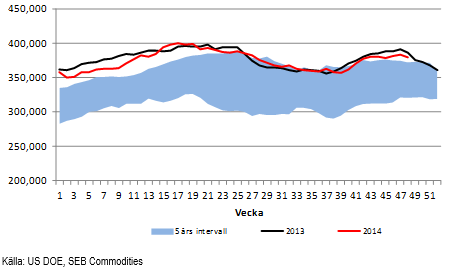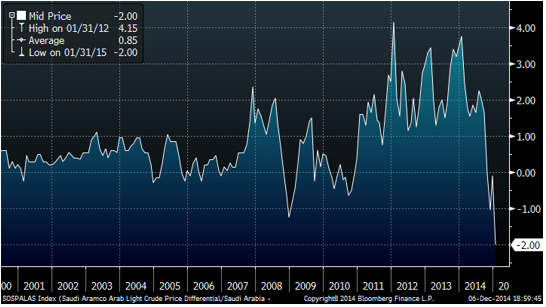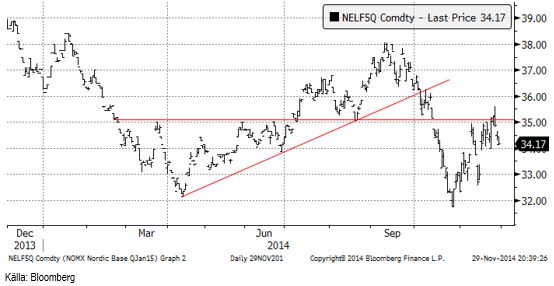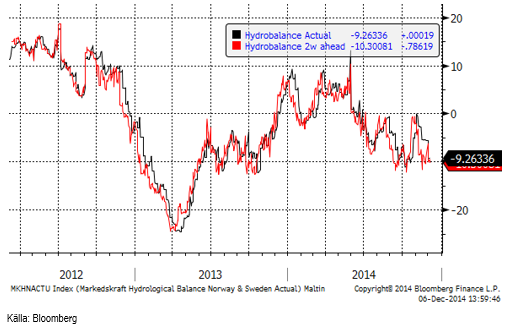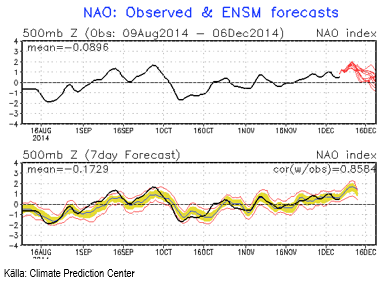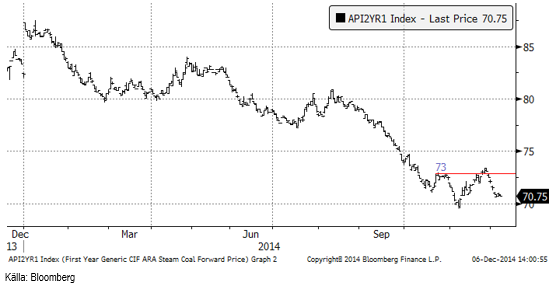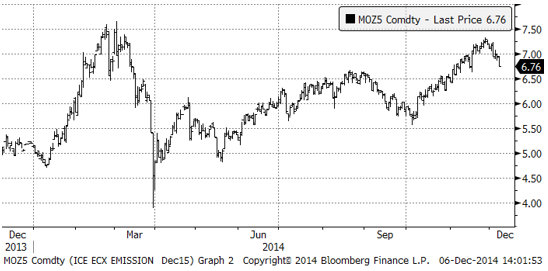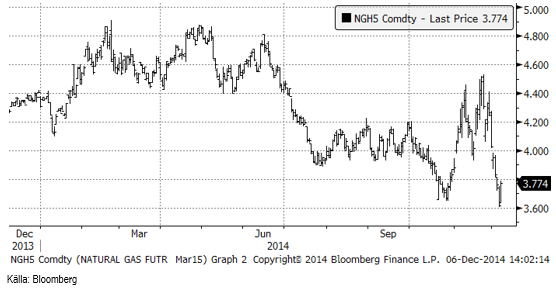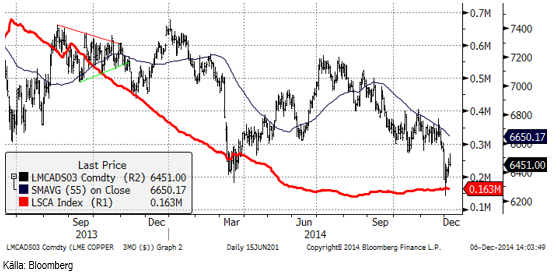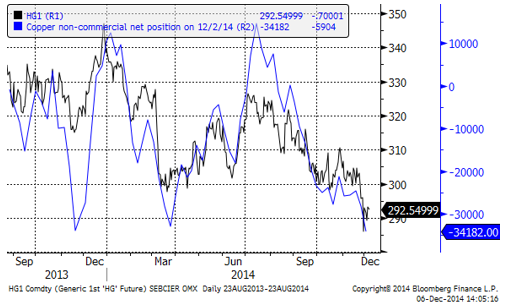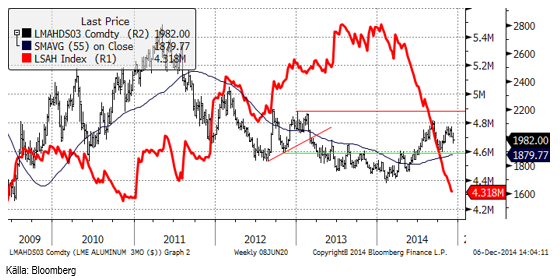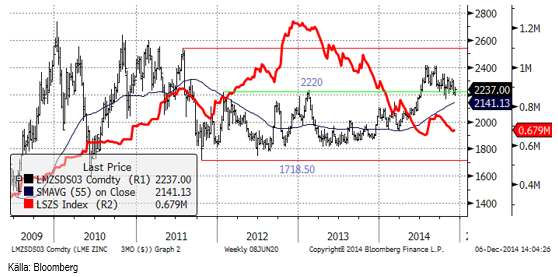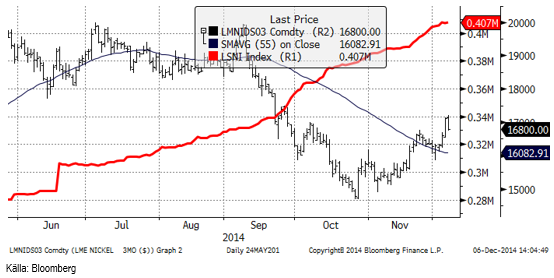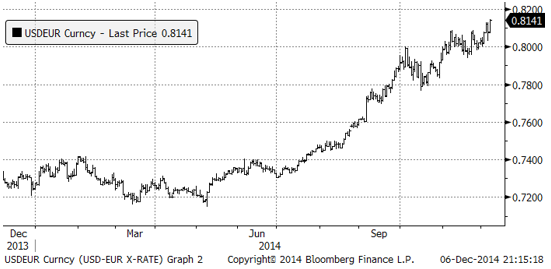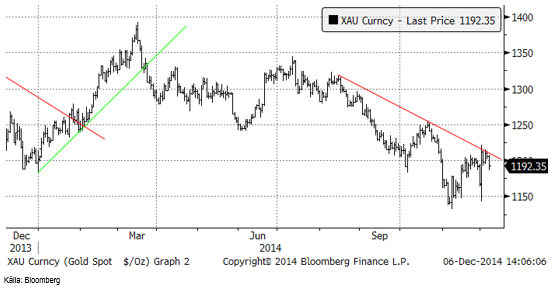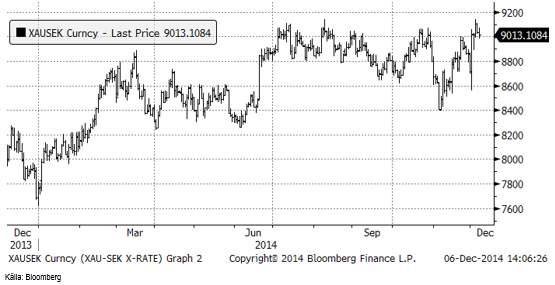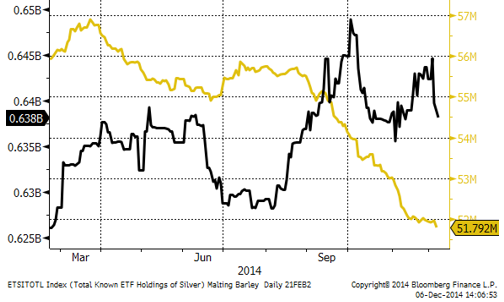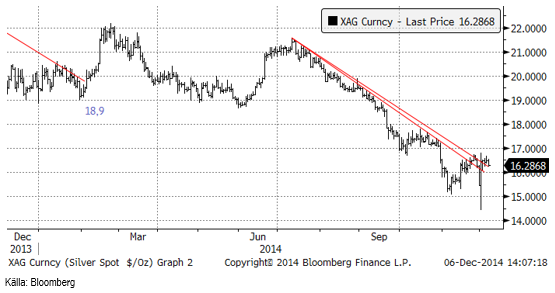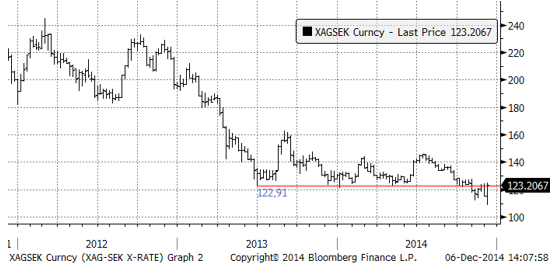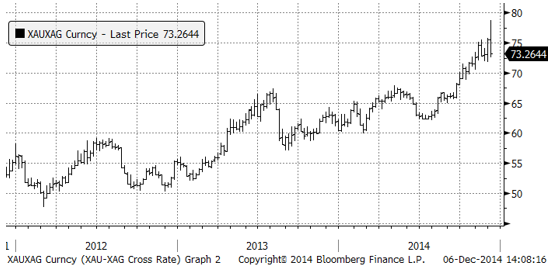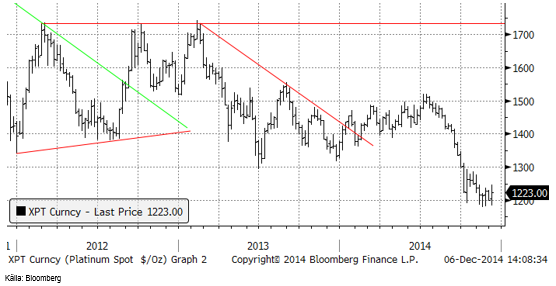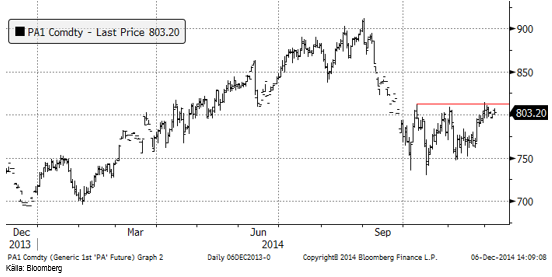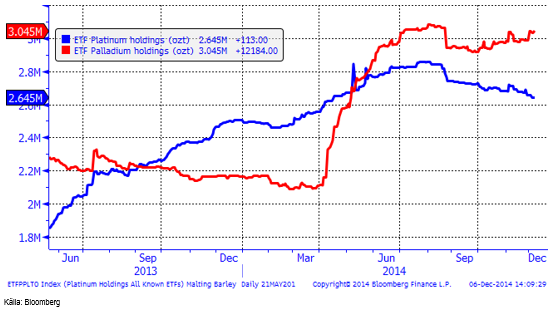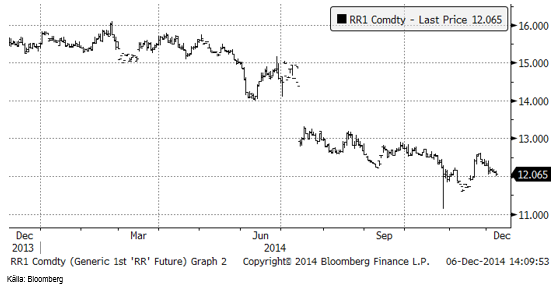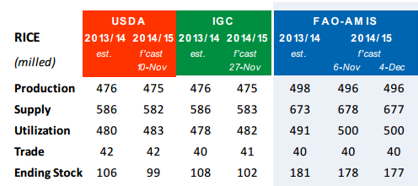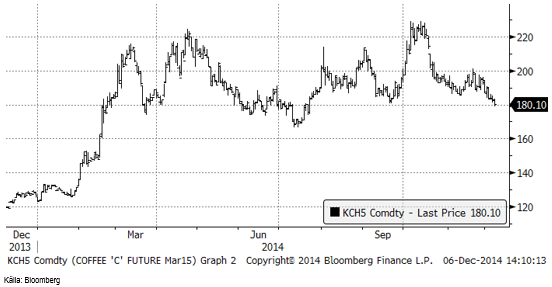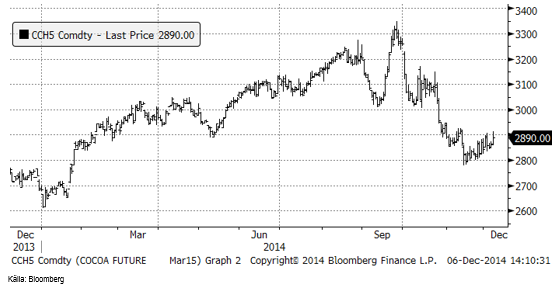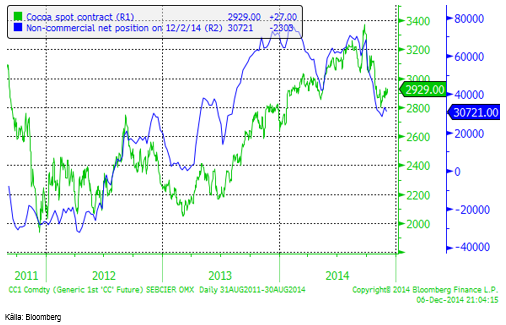Analys
SEB – Råvarukommentarer, 8 december 2014
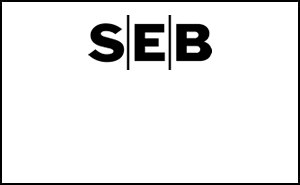
Veckans rekommendationer
Råolja – Brent
Prisraset hejdade sig något vid 70 dollar i veckan, men gled successivt under den nivån och stängde på 69.07 i fredags. Nyheten att Irak planerar att öka exporten av råolja under nästa år (2015) från nuvarande 2.75 mbpd till 3.2 mbpd tyngde marknaden.
Lagren i USA sjönk med 3.7 miljoner fat enligt DOE:s statistik i veckan. Det är helt i enlighet med säsongsmönstret.
Nedan ser vi ett diagram på antalet oljeriggar i USA, enligt Baker Hughes statistik (svart). Antalet riggar i drift ökade med 3 till 1920 i veckan som gick. Det var nog inte väntat med en ökning. Vi ser dock ändå att antalet i drift har planat ut på mellan 1920 och 1930 riggar, i spåren av oljeprisfallet. Detta är säkerligen en besvikelse för dem som hoppats på en botten i oljepriset, att antalet inte minskar mer.
Saudi-ARAMCO har sänkt sitt pris för export till Asien och USA till den lägsta nivån sedan åtminstone år 2000. De säljer nu sin olja 2 dollar under benchmarkindexet. Så sent som vid årsskiftet såldes oljan för 3.50 dollar över benchmarkindexet. Priset är alltså till och med lägre än det var år 2008.
Det här är naturligtvis ett tecken på att Saudierna verkligen vill sälja så mycket olja de kan, för att via volym försöka hålla landets oljeintäkter uppe. Det är helt i linje med den spelteoretiska analys vi gjorde för ganska länge sedan, att skiffertekniken gör att OPEC som kartell upphör att fungera och oljeländerna går över till att agera såsom under fri konkurrens. Tidskriften The Economist nämnde samma analysmetod, spelteori i veckan som gick. Det centrala i den är inte att volymen från skiffertekniken behöver vara så värst stor, utan att den finns och är tillgänglig för ett stort antal länder.
Vi får ofta frågan vad kostnaden för skifferolja är i USA, eftersom man ser många olika uppgifter på det. Det som gör det svårt att svara på frågan är att tekniken utvecklas med ca 30% effektiviseringsgrad per år. En kostnad på 60 dollar för två år sedan kan alltså pga effektivitetsförbättringar vara 29 dollar per fat i år. Geologin spelar också roll, t ex hur djupt skifferlagret ligger. Olika fält har olika kostnadsnivå i USA. Så det går inte att svara entydigt vad kostnaden för att utvinna skifferolja är just nu. US DOE säger dock att den redan i år är ett par dollar billigare än konventionell olja att utvinna i USA.
Veckan som kommer är händelserik på oljemarknaden. Här är schemat:
Måndag 8 december. China crude oil, oil products and coal imports and exports data.
Tisdag 9 december. 1800 CET. US Department Of Energy monthly energy report – Short Term Energy Outlook (STEO)
Onsdag 10 december. OPEC Monthly Oil Market Report (OMR)
Onsdag 10 december. 1630 CET. US Department Of Energy. Weekly US oil inventory data.
Fredag 12 december. 1000 CET. International Energy Market OMR.
Fredag 12 december. 1900 CET. Oil and Gas rig count by Baker Hughes
Vi rekommenderar en kort position, t ex med BEAR OLJA X2 S.
Elektricitet
Priset på elektricitet föll mot slutet av veckan. Den nordiska situationen är att vädret ser mildare ut än normalt. Det är lite högre spotpriser. Prisområdena ser ut som de brukar, med lite lägre pris i norr och lite högre i söder.
Det är kallare än normalt i Europa, så det är lite högre pris på EEX, men forwardpriserna är under tryck.
Kolmarknaden är under press. Kolpriset påverkas mycket av Brent-priserna, naturligtvis.
Hydrologisk balans har enligt 2-veckors prognosen sjunkit från -7.7 TWh till -10.3 TWh.
Den Nordatlantiska Oscillationen, där ett NAO som är positivt innebär att varma och fuktiga vindar från sydväst kommer in över Norden, har i en månad medfört väder som präglats av detta. Som vi kan se förutspås denna tendens att fortsätta och vid ungefär den 16 december eventuellt gå över till negativt. Negativt NAO innebär att stillastående ishavskyla kommer ner över Norden, men stjärnklart, vindstilla och knasterkallt väder. Eftersom det både är kallt och vindkraftverken står stilla innebär det högre pris på elektricitet. Det mildra väder vi har nu, kan alltså komma att följas av kallare.
Nedan ser vi terminskontraktet för leverans av kol under 2015, som sjunkit från 72.10 dollar per ton till 70.75 i fredags.
Priset på utsläppsrätter vände nedåt i veckan.
Naturgas
Naturgaspriset föll kraftigt i veckan, från 4.03 dollar till 3.77 dollar per miljoner BTU.
Koppar
November avslutades med massiv likvidering av koppar. Varje tänkbart tekniskt stöd bröts i den våg av likvidering av köpta positioner och etablering av nya korta positioner som ägde rum. Det verkar som om detta började i Asien, men det är svårt att utröna vad det var som utlöste paniken – möjligen besvikelsen över att Chiles produktion i oktober var den högsta på fem månader. Prisfallet fortsatte in i veckan som gick och även LME noterade en botten som var lägre än den i mars, ner till 6230 dollar per ton. Prisnedgången till den nivån möttes av stora köpordrar som inte bara absorberade säljordrarna, utan lyfte priset till 6450 dollar till slutet av dagen – en mycket stor prisrörelse för att vara en dag i kopparmarknaden!
Tekniskt kan vi dock se att en ny lägre botten noterades, lägre än den i mars. Några kanske minns att i mars var det SRB, den kinesiska ”Strategic Reserve Bureau”, som klev in och köpte på sig stora mängder koppar. Det är möjligt att det var SRB som köpte igen, men det är svårt att veta, naturligtvis. Men bara det faktum att det KAN ha varit dem, gjorde att säljare avhöll sig från att sälja på vad som annars hade varit en tydlig teknisk säljsignal.
Spekulantkollektivet (non-commercials i CFTC:s data) har fortsatt att sälja terminer på koppar, som vi ser i diagrammet nedan.
Aluminium
Skillnaden mellan cash och 3-månaders terminspris gick från 27 dollar i backwardation till under veckan. De längre terminerna handlas med contango, men mindre än normalt. Dec-14 till Dec-15 handlas t ex 20 dollar i contango mot 40-50 dollar för en månad sedan. Flödet mellan annullerade lagerbevis och nyskapade lagerbevis antyder att det sker något lite ”lending” i marknaden, enligt Metal Bulletin. Det verkar rimligt med tanke på att det är backwardation. Marknaden för fysisk metall (premierna) är lite svagare i Europa. Rotterdamnoteringen har kommit ner med 10 dollar till 420 dollar (över LME:s pris). Det officiella indexet för den amerikanska Mellanvästern håller sig fortfarande stabilt vid 520 dollar, men en del rapporter antyder att det skett stora affärer under den nivån. Om det är början på en minskning i premien är svårt att säga, men det kan vara början.
Zink
Zinkpriset låg kvar i den senaste tidens tradingintervall, trots prisnedgången i koppar. Priset rörde sig huvudsakligen nedåt i början av veckan, men repade sig mot slutet. Den underliggande trenden tror vi är uppåtriktad, men marknaden verkar ha svårt att röra sig åt något håll just nu.
Underskottet i marknaden känns ännu inte av eftersom lagren år så höga. Investerare som köpt in sig i ”bull caset” på zink har gått i och ur marknaden och skapat en ganska fluktuerande marknad. Det verkar som om detta läge kan bestå ett tag innan en ny uppgångsfas börjar (som vi tror blir någon gång i början på nästa år).
Vi behåller köprekommendationen på ZINK S.
Nickel
Nickelpriset som rekylerade för en vecka sedan, fann ny styrka i veckan som gick. Vi har i ett år fokuserat på utbudssidan, med Indonesiens exportstopp i fokus. Förra veckan noterade vi att efterfrågan långsiktigt kan få en knäck om det lägre oljepriset dämpar skifferrevolutionen i USA. I Metal Bulletins senaste rapport om rostfritt stål, skriver de (inte förvånande) att en ökning i efterfrågan väntas det kommande kvartalet. Men även fortsättningsvis kommer nog utbudssituationen att fortsätta att vara i marknadens fokus. Den tydligaste indikatorn är LME:s lager. Det kan också vara intressant att studera annullerade lagerbevis (warrants) och hur den volymen utvecklas. Just nu annulleras mest lagerbevis i Malaysia och därifrån går flödet vanligtvis till Kina.
Tekniskt har priset vänt upp igen till 17,000 dollar, som noterades i torsdags. Fredagens handel var volatil och slutade med vinsthemtagningar och ett stängningspris på 16,750 dollar.
Guld
Guldpriset föll från det tekniska motståndet i fredags efter arbetsmarknadsstatstiken i USA publicerats. Den visade att amerikanska företag anställt 321,000 personer i November och det var ungefär 100,000 personer fler än vad marknaden hade förväntat sig. Det är den starkaste månaden på arbetsmarknaden sedan januari 2012.
Detta fick dollarn att fortsätta stärkas mot andra valutor. I diagrammet nedan ser vi hur USDEUR (alltså priset på en dollar uttryckt i euro) förändrat sig det senaste året.
Nedan ser vi hur guldpriset i dollar utvecklat sig, alltså växelkursen XAUUSD.
Den svenska kronan är svag och har gått från 9.10 mot euron i början av september till 9.28 i fredags. Det innebär att guldpriset faktiskt stod på årshögsta i veckan som gick, även om en viss rekyl noterades i torsdags och fredags.
Institutionella investerare har fortsatt att sälja guld igen och nu har de även vräkt ut silver. Antagligen sker en hel del likvidering av generella råvarufonder, till fördel för generella aktiefonder, en process som antagligen fått mer fart i takt med oljeprisets nedgång.
Vi fortsätter med neutral rekommendation på guld.
Silver
Silverpriset står och väger. Tekniskt har motstånden brutits, oavsett hur man drar linjen, men det finns inget momentum uppåt i prisrörelsen, så detta behöver inte betyda att den fallande trenden är bruten.
Silverpriset i kronor befinner sig fortfarande i det läge, där metallen enligt den tekniska analysen borde säljas, så länge priset inte går högre, vilket skulle förändra den tekniska bilden av marknaden.
Silver har i och med prisuppgången i veckan värderats upp i förhållande till guld. Fortfarande är dock silver ”billigt” i förhållande till guld. Det betyder i och för sig inte att det inte kan bli ännu billigare.
Platina & Palladium
Priset på platina reste sig från 1200 dollar och stängde 23 dollar högre i fredags. Fortfarande är dock marknaden i ”sidledes” konsolidering. Priset skulle behöva gå över 1300 för att man ska våga tro på att vinden har vänt. Tills vidare ser vi dock uppgångar som potentiella säljtillfällen.
Palladiumpriset gjorde ett försök att bryta det tekniska motståndet, men rekylerade ner i veckan. I fredag torsdags gjordes ett nytt försök från veckans lägsta pris, men köparna orkade inte ända fram, delvis förmodligen på grund av dollarns styrka. Skulle motståndet brytas, skulle vi vilja köpa (ännu mer) palladium.
Nedanför ser vi hur mycket metall som finns i börshandlade fonder för platina respektive palladium. Investerare har fortsatt att sälja platina och köpa palladium den senaste veckan.
Ris
Priset på ris sjönk med 0.25 cent i veckan till 12.065 cent per pund. Priset pressas samtidigt som skörden pågår som bäst runtom i världen. 12 cent verkar vara någon slags psykologisk stödnivå.
FAO / AMIS lämnade produktionsestimatet oförändrat i rapporten som kom den 4 december. Utgående lager sänks med 1 mt till 177 mt.
12 cent verkar vara ett stöd, samtidigt som FAO justerar ner utgående lager. Det finns trots allt en antydan till positiva tongångar för priset på ris.
Kaffe
Kaffepriset (mars) har fortsatt att försvagas, såsom vi mer eller mindre förväntat oss. Det nederbördsrika vädret i Brasilien fortsätter. Terminen stängde på 180.10 cent per pund i fredags, efter att ha handlats ner ganska ordentligt under dagen. Bryts 180-centsnivån finns nästa stöd vid 170 cent. Med ett fundamentalt långsiktigt överskott i marknaden och en genomsnittlig produktionskostnad i Brasilien på ca 150 cent, enligt en rapport från USDA för ett år sedan, skulle ett rimligt pris kunna ligga vid 140 – 160 cent.
Vi har neutral rekommendation, men bryts 180 cent, går vi omedelbart kort via t ex BEAR KAFFE X1 S.
Kakao
Kakaopriset befinner sig i vad som ser ut som en rekyl mot den huvudsakliga trenden, som vi tror är en fallande pristrend. ICCO säger att produktionen är stigande och går mot ett överskott. Det talar för ett lägre pris.
Den senaste veckan har ”non-commercials” sålt ytterligare lite terminskontrakt .De har fortfarande 30721 kontrakt kvar att sälja till dess de når en neutral position.
Vi behåller positionen i SHORT KAKAO A S. Nu finns även en BEAR KAKAO X1 S med 1 gånger negativ daglig hävstång och en BEAR KAKAO X4 S med fyra gångers negativ daglig hävstång.
För fler jordbruksanalyser se SEB-bankens andra analysbrev.
[box]SEB Veckobrev Veckans råvarukommentar är producerat av SEB Merchant Banking och publiceras i samarbete och med tillstånd på Råvarumarknaden.se[/box]
Disclaimer
The information in this document has been compiled by SEB Merchant Banking, a division within Skandinaviska Enskilda Banken AB (publ) (“SEB”).
Opinions contained in this report represent the bank’s present opinion only and are subject to change without notice. All information contained in this report has been compiled in good faith from sources believed to be reliable. However, no representation or warranty, expressed or implied, is made with respect to the completeness or accuracy of its contents and the information is not to be relied upon as authoritative. Anyone considering taking actions based upon the content of this document is urged to base his or her investment decisions upon such investigations as he or she deems necessary. This document is being provided as information only, and no specific actions are being solicited as a result of it; to the extent permitted by law, no liability whatsoever is accepted for any direct or consequential loss arising from use of this document or its contents.
About SEB
SEB is a public company incorporated in Stockholm, Sweden, with limited liability. It is a participant at major Nordic and other European Regulated Markets and Multilateral Trading Facilities (as well as some non-European equivalent markets) for trading in financial instruments, such as markets operated by NASDAQ OMX, NYSE Euronext, London Stock Exchange, Deutsche Börse, Swiss Exchanges, Turquoise and Chi-X. SEB is authorized and regulated by Finansinspektionen in Sweden; it is authorized and subject to limited regulation by the Financial Services Authority for the conduct of designated investment business in the UK, and is subject to the provisions of relevant regulators in all other jurisdictions where SEB conducts operations. SEB Merchant Banking. All rights reserved.
Analys
’wait and see’ mode

So far this week, Brent Crude prices have strengthened by USD 1.3 per barrel since Monday’s opening. While macroeconomic concerns persist, they have somewhat abated, resulting in muted price reactions. Fundamentals predominantly influence global oil price developments at present. This week, we’ve observed highs of USD 89 per barrel yesterday morning and lows of USD 85.7 per barrel on Monday morning. Currently, Brent Crude is trading at a stable USD 88.3 per barrel, maintaining this level for the past 24 hours.

Additionally, there has been no significant price reaction to Crude following yesterday’s US inventory report (see page 11 attached):
- US commercial crude inventories (excluding SPR) decreased by 6.4 million barrels from the previous week, standing at 453.6 million barrels, roughly 3% below the five-year average for this time of year.
- Total motor gasoline inventories decreased by 0.6 million barrels, approximately 4% below the five-year average.
- Distillate (diesel) inventories increased by 1.6 million barrels but remain weak historically, about 7% below the five-year average.
- Total commercial petroleum inventories (crude + products) decreased by 3.8 million barrels last week.
Regarding petroleum products, the overall build/withdrawal aligns with seasonal patterns, theoretically exerting limited effect on prices. However, the significant draw in commercial crude inventories counters the seasonality, surpassing market expectations and API figures released on Tuesday, indicating a draw of 3.2 million barrels (compared to Bloomberg consensus of +1.3 million). API numbers for products were more in line with the US DOE.
Against this backdrop, yesterday’s inventory report is bullish, theoretically exerting upward pressure on crude prices.
Yet, the current stability in prices may be attributed to reduced geopolitical risks, balanced against demand concerns. Markets are adopting a wait-and-see approach ahead of Q1 US GDP (today at 14:30) and the Fed’s preferred inflation measure, “core PCE prices” (tomorrow at 14:30). A stronger print could potentially dampen crude prices as market participants worry over the demand outlook.
Geopolitical “risk premiums” have decreased from last week, although concerns persist, highlighted by Ukraine’s strikes on two Russian oil depots in western Russia and Houthis’ claims of targeting shipping off the Yemeni coast yesterday.
With a relatively calmer geopolitical landscape, the market carefully evaluates data and fundamentals. While the supply picture appears clear, demand remains the predominant uncertainty that the market attempts to decode.
Analys
Also OPEC+ wants to get compensation for inflation

Brent crude has fallen USD 3/b since the peak of Iran-Israel concerns last week. Still lots of talk about significant Mid-East risk premium in the current oil price. But OPEC+ is in no way anywhere close to loosing control of the oil market. Thus what will really matter is what OPEC+ decides to do in June with respect to production in Q3-24 and the market knows this very well. Saudi Arabia’s social cost-break-even is estimated at USD 100/b today. Also Saudi Arabia’s purse is hurt by 21% US inflation since Jan 2020. Saudi needs more money to make ends meet. Why shouldn’t they get a higher nominal pay as everyone else. Saudi will ask for it

Brent is down USD 3/b vs. last week as the immediate risk for Iran-Israel has faded. But risk is far from over says experts. The Brent crude oil price has fallen 3% to now USD 87.3/b since it became clear that Israel was willing to restrain itself with only a muted counter attack versus Israel while Iran at the same time totally played down the counterattack by Israel. The hope now is of course that that was the end of it. The real fear has now receded for the scenario where Israeli and Iranian exchanges of rockets and drones would escalate to a point where also the US is dragged into it with Mid East oil supply being hurt in the end. Not everyone are as optimistic. Professor Meir Javedanfar who teaches Iranian-Israeli studies in Israel instead judges that ”this is just the beginning” and that they sooner or later will confront each other again according to NYT. While the the tension between Iran and Israel has faded significantly, the pain and anger spiraling out of destruction of Gaza will however close to guarantee that bombs and military strifes will take place left, right and center in the Middle East going forward.
Also OPEC+ wants to get paid. At the start of 2020 the 20 year inflation adjusted average Brent crude price stood at USD 76.6/b. If we keep the averaging period fixed and move forward till today that inflation adjusted average has risen to USD 92.5/b. So when OPEC looks in its purse and income stream it today needs a 21% higher oil price than in January 2020 in order to make ends meet and OPEC(+) is working hard to get it.
Much talk about Mid-East risk premium of USD 5-10-25/b. But OPEC+ is in control so why does it matter. There is much talk these days that there is a significant risk premium in Brent crude these days and that it could evaporate if the erratic state of the Middle East as well as Ukraine/Russia settles down. With the latest gains in US oil inventories one could maybe argue that there is a USD 5/b risk premium versus total US commercial crude and product inventories in the Brent crude oil price today. But what really matters for the oil price is what OPEC+ decides to do in June with respect to Q3-24 production. We are in no doubt that the group will steer this market to where they want it also in Q3-24. If there is a little bit too much oil in the market versus demand then they will trim supply accordingly.
Also OPEC+ wants to make ends meet. The 20-year real average Brent price from 2000 to 2019 stood at USD 76.6/b in Jan 2020. That same averaging period is today at USD 92.5/b in today’s money value. OPEC+ needs a higher nominal price to make ends meet and they will work hard to get it.
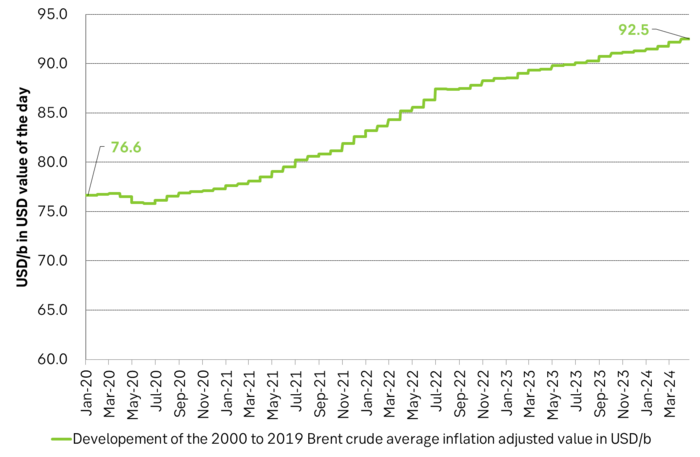
Inflation adjusted Brent crude price versus total US commercial crude and product stocks. A bit above the regression line. Maybe USD 5/b risk premium. But type of inventories matter. Latest big gains were in Propane and Other oils and not so much in crude and products

Total US commercial crude and product stocks usually rise by 4-5 m b per week this time of year. Gains have been very strong lately, but mostly in Propane and Other oils

Last week’s US inventory data. Big rise of 10 m b in commercial inventories. What really stands out is the big gains in Propane and Other oils
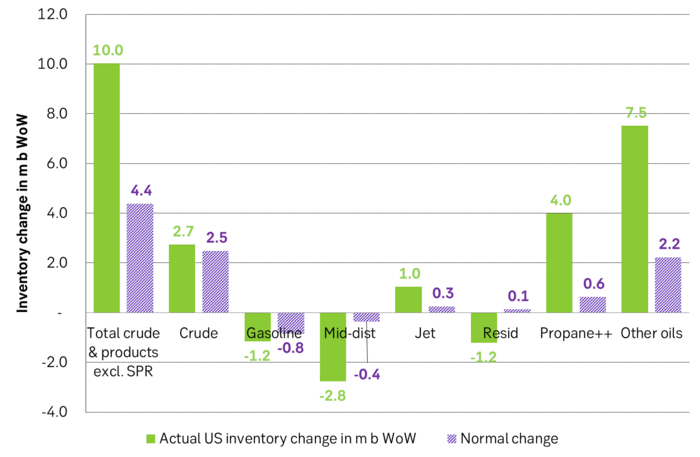
Take actual changes minus normal seasonal changes we find that US commercial crude and regular products like diesel, gasoline, jet and bunker oil actually fell 3 m b versus normal change.

Analys
Nat gas to EUA correlation will likely switch to negative in 2026/27 onward

Historically positive Nat gas to EUA correlation will likely switch to negative in 2026/27 onward

Historically there has been a strong, positive correlation between EUAs and nat gas prices. That correlation is still fully intact and possibly even stronger than ever as traders increasingly takes this correlation as a given with possible amplification through trading action.
The correlation broke down in 2022 as nat gas prices went ballistic but overall the relationship has been very strong for quite a few years.
The correlation between nat gas and EUAs should be positive as long as there is a dynamical mix of coal and gas in EU power sector and the EUA market is neither too tight nor too weak:
Nat gas price UP => ”you go black” by using more coal => higher emissions => EUA price UP
But in the future we’ll go beyond the dynamically capacity to flex between nat gas and coal. As the EUA price moves yet higher along with a tightening carbon market the dynamical coal to gas flex will max out. The EUA price will then trade significantly above where this flex technically will occur. There will still be quite a few coal fired power plants running since they are needed for grid stability and supply amid constrained local grids.
As it looks now we still have such overall coal to gas flex in 2024 and partially in 2025, but come 2026 it could be all maxed out. At least if we look at implied pricing on the forward curves where the forward EUA price for 2026 and 2027 are trading way above technical coal to gas differentials. The current forward pricing implications matches well with what we theoretically expect to see as the EUA market gets tighter and marginal abatement moves from the power sector to the industrial sector. The EUA price should then trade up and way above the technical coal to gas differentials. That is also what we see in current forward prices for 2026 and 2027.
The correlation between nat gas and EUAs should then (2026/27 onward) switch from positive to negative. What is left of coal in the power mix will then no longer be dynamically involved versus nat gas and EUAs. The overall power price will then be ruled by EUA prices, nat gas prices and renewable penetration. There will be pockets with high cost power in the geographical points where there are no other alternatives than coal.
The EUA price is an added cost of energy as long as we consume fossil energy. Thus both today and in future years we’ll have the following as long as we consume fossil energy:
EUA price UP => Pain for consumers of energy => lower energy consumption, faster implementation of energy efficiency and renewable energy => lower emissions
The whole idea with the EUA price is after all that emissions goes down when the EUA price goes up. Either due to reduced energy consumption directly, accelerated energy efficiency measures or faster switch to renewable energy etc.
Let’s say that the coal to gas flex is maxed out with an EUA price way above the technical coal to gas differentials in 2026/27 and later. If the nat gas price then goes up it will no longer be an option to ”go black” and use more coal as the distance to that is too far away price vise due to a tight carbon market and a high EUA price. We’ll then instead have that:
Nat gas higher => higher energy costs with pain for consumers => weaker nat gas / energy demand & stronger drive for energy efficiency implementation & stronger drive for more non-fossil energy => lower emissions => EUA price lower
And if nat gas prices goes down it will give an incentive to consume more nat gas and thus emit more CO2:
Cheaper nat gas => Cheaper energy costs altogether, higher energy and nat gas consumption, less energy efficiency implementations in the broader economy => emissions either goes up or falls slower than before => EUA price UP
Historical and current positive correlation between nat gas and EUA prices should thus not at all be taken for granted for ever and we do expect this correlation to switch to negative some time in 2026/27.
In the UK there is hardly any coal left at all in the power mix. There is thus no option to ”go black” and burn more coal if the nat gas price goes up. A higher nat gas price will instead inflict pain on consumers of energy and lead to lower energy consumption, lower nat gas consumption and lower emissions on the margin. There is still some positive correlation left between nat gas and UKAs but it is very weak and it could relate to correlations between power prices in the UK and the continent as well as some correlations between UKAs and EUAs.
Correlation of daily changes in front month EUA prices and front-year TTF nat gas prices, 250dma correlation.
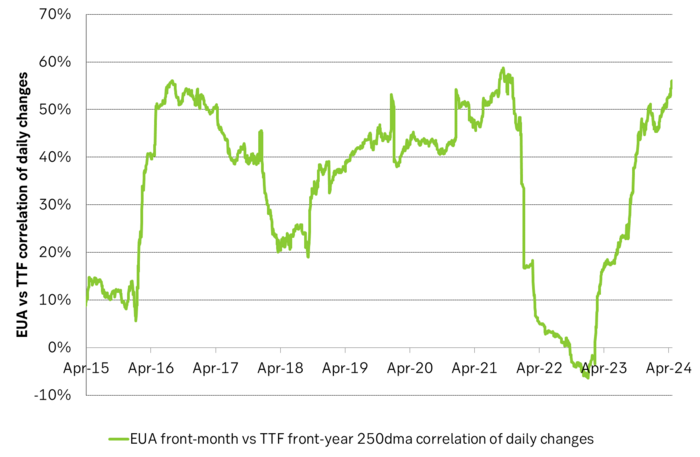
EUA price vs front-year TTF nat gas price since March 2023
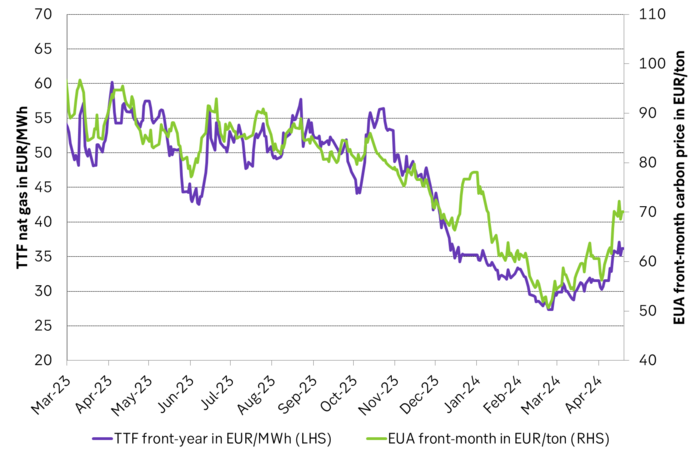
Front-month EUA price vs regression function of EUA price vs. nat gas derived from data from Apr to Nov last year.
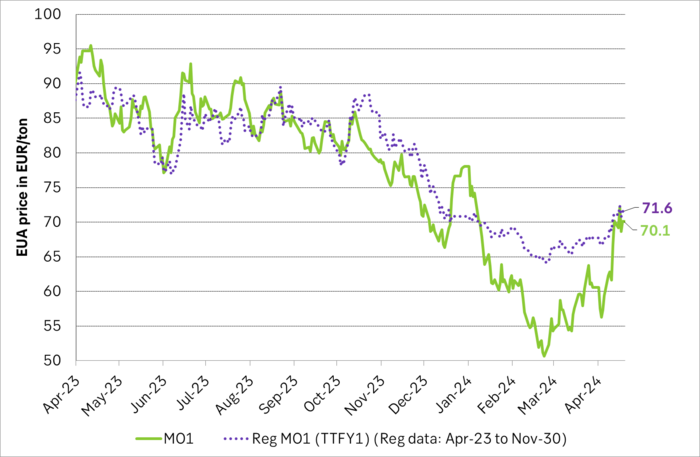
The EUA price vs the UKA price. Correlations previously, but not much any more.
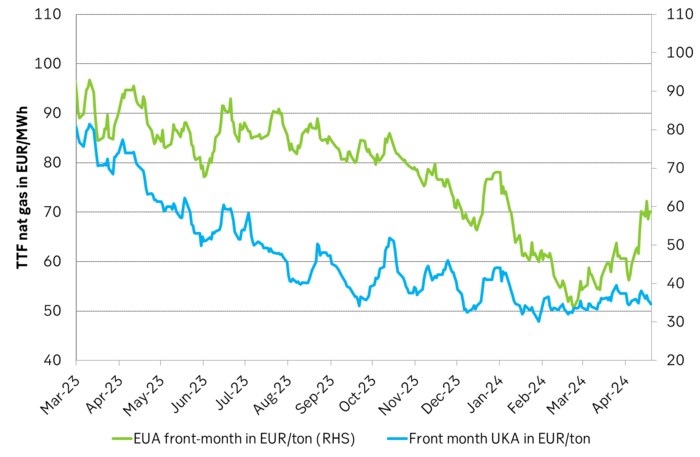
Forward German power prices versus clean cost of coal and clean cost of gas power. Coal is totally priced out vs power and nat gas on a forward 2026/27 basis.

Forward price of EUAs versus technical level where dynamical coal to gas flex typically takes place. EUA price for 2026/27 is at a level where there is no longer any price dynamical interaction or flex between coal and nat gas. The EUA price should/could then start to be negatively correlated to nat gas.

Forward EAU price vs. BNEF base model run (look for new update will come in late April), SEB’s EUA price forecast.
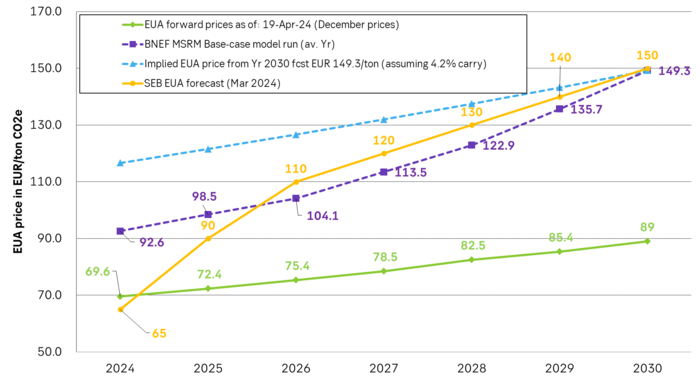
-

 Nyheter3 veckor sedan
Nyheter3 veckor sedanGuldpriset når nytt all time high och bryter igenom 2300 USD
-

 Nyheter3 veckor sedan
Nyheter3 veckor sedanUSAs stigande konsumtion av naturgas
-

 Nyheter3 veckor sedan
Nyheter3 veckor sedanCentralbanker fortsatte att köpa guld under februari
-

 Nyheter3 veckor sedan
Nyheter3 veckor sedanKakaomarknaden är extrem för tillfället
-

 Nyheter3 veckor sedan
Nyheter3 veckor sedanHur mår den svenska skogsbraschen? Två favoritaktier
-

 Nyheter4 veckor sedan
Nyheter4 veckor sedanBoliden på 20 minuter
-

 Nyheter3 veckor sedan
Nyheter3 veckor sedanBetydande underskott i utbudet av olja kan få priset att blossa upp
-

 Nyheter4 veckor sedan
Nyheter4 veckor sedanMyten om guld – Den magiska metallen född från stjärnstoft


